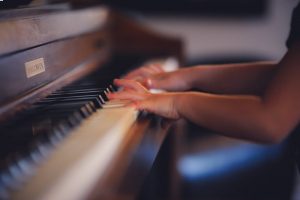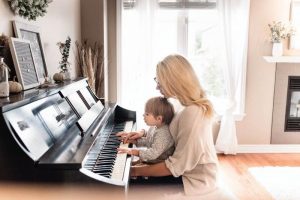Have you been thinking of introducing your youngster to music? Wondering if there are piano lessons for toddlers, or healthy ways to get your child interested and engaged with an instrument?
Musical abilities can be fostered from a very early age, and the piano is an especially effective instrument for developing them. If your child can recognize numbers one through five and the letters A through G, then they may be ready for exploring the piano. Playing piano can offer toddler-aged children an entertaining way to develop motor functions, and to learn how to relate what they hear to what they touch, which promotes mental acuity.
There are several toddler piano options to explore, any of which would make for excellent presents this holiday season. A simple Google search will bring up recommendations from sites like experiencedmommy.com. I will leave the product-review aspect of getting started to them. Instead, I will focus on ways to get your child started once you have a piano in front of them.
Exploring the Piano Keyboard
If you put a piano in front of a young child without any direction, odds are that they will start banging whatever and as many piano keys that they can reach in a random and chaotic way. While they may find this entertaining for a little while, nothing particularly useful comes out of the experience, and the parent may quickly start to question their life choices. Therefore, when you start your child on a piano, it is important to set a framework for them. Give them specific parameters and concepts with which they can experiment and explore in a productive way.
For example, you can begin with a simple rule like “only touch one key at a time.” This will give them the space to explore the piano however they want while at the same time bring some order to the chaos. From here, a parent or teacher can teach and then quiz simple musical ideas, such as the differences between playing high sounds (on right side of the piano) and playing low sounds (on the left side). One can also explore simple binary concepts like loud vs. soft, fast vs. slow, or short vs. long rhythms. These kinds of things can be easily gamified for a fun and effective learning framework.
Embrace the Counting
Many children enjoy showing off their ability to count. This is very convenient for early music training, since regular counting is what learning rhythm and steady beats is all about! Counting can be used at the piano in a variety of ways to get the child acquainted with the keyboard as well. And it shows them where patterns start to repeat. For example, the black keys on the keyboard are organized into groups of two and three. Teaching your child to find these groups of black keys can teach them to recognize certain parts of the keyboard more quickly.
Counting forward and backward can reinforce the musical concept of higher and lower sounds, and shows how they are lined up on a piano keyboard. An easy way to teach this idea is to start a child on the left side of the keyboard and play one key at a time while counting from one to five. You can restrict them to playing only white keys or only black keys for more structure. Then, have the child reverse what they played while counting backward. If they can sing along, even better! The point is that they are learning to organize what they see with what they touch and what they hear.
Simple Songs
As children explore the piano in these simple, structured ways, it will eventually lead them to learn simple songs. This is, after all, what the melody of a song essentially is: a simple, structured musical idea. “Hot Crossed Buns,” for example, is a simple song that can be played on a group of three black keys. “Mary Had a Little Lamb” can be played using only the white keys C through G (if you are not musically inclined, the piano keys are labeled with their letter names on most pianos that are designed for toddlers). These kind of simple songs can give children something recognizable to practice, and they can be taught using a counting system.
As I mentioned at the beginning, giving toddlers a piano to play with can aid development in several different ways. It is a detailed tactile toy for developing fine motor functions, it has visually stimulating patterns in the way that the keys are organized, and of course, it is aurally diverse in a way that allows children to connect what they hear with what they see and touch in a highly refined way. Especially if you or a teacher can guide their play with some simple frameworks, piano can be an excellent way to help toddlers develop while fostering a possibly life-long passion for music.
Lance Russell



